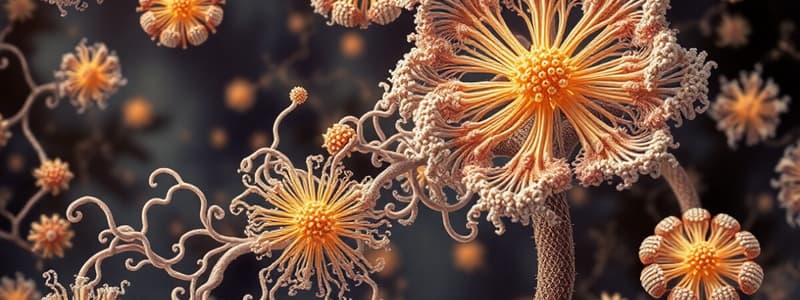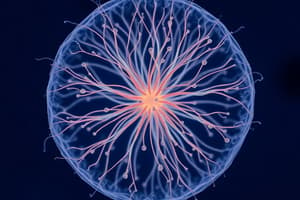Podcast
Questions and Answers
What is the mortality rate associated with the mentioned resistant yeast?
What is the mortality rate associated with the mentioned resistant yeast?
- 25%
- 30%
- 35% (correct)
- 20%
Candida albicans is only an opportunistic pathogen in healthy individuals.
Candida albicans is only an opportunistic pathogen in healthy individuals.
False (B)
Which yeast is commonly used to leaven bread?
Which yeast is commonly used to leaven bread?
Saccharomyces cerevisiae
Pneumocystis jirovecii is classified as a yeast form of ______.
Pneumocystis jirovecii is classified as a yeast form of ______.
Match the following fungi with their associated characteristics:
Match the following fungi with their associated characteristics:
Which of the following fungi can exhibit dimorphism?
Which of the following fungi can exhibit dimorphism?
Aspergillus can cause allergic reactions and may form fungus balls in immunocompromised individuals.
Aspergillus can cause allergic reactions and may form fungus balls in immunocompromised individuals.
What process do haploid yeast cells undergo in a nutrient-limited environment to reproduce sexually?
What process do haploid yeast cells undergo in a nutrient-limited environment to reproduce sexually?
The diploid cells of yeast may undergo ______ to regenerate haploid cells.
The diploid cells of yeast may undergo ______ to regenerate haploid cells.
Which of the following diseases is caused by Trypanosomes?
Which of the following diseases is caused by Trypanosomes?
Most amebas are pathogenic to humans.
Most amebas are pathogenic to humans.
What is the primary human pathogen associated with Balantidia?
What is the primary human pathogen associated with Balantidia?
The flow of nutrients through the cytoplasm in amebas is mediated by _______ proteins.
The flow of nutrients through the cytoplasm in amebas is mediated by _______ proteins.
Match the following protozoa with their associated diseases:
Match the following protozoa with their associated diseases:
Which type of pathogen causes primary amoebic meningoencephalitis?
Which type of pathogen causes primary amoebic meningoencephalitis?
Algae are primarily pathogenic to humans.
Algae are primarily pathogenic to humans.
Name one type of arthropod that can directly infect humans.
Name one type of arthropod that can directly infect humans.
The disease caused by the protozoa __________ is characterized by severe dysentery.
The disease caused by the protozoa __________ is characterized by severe dysentery.
Which genus of protozoa is known for causing Giardia?
Which genus of protozoa is known for causing Giardia?
Which feature is characteristic of filamentous amebas like foraminiferans?
Which feature is characteristic of filamentous amebas like foraminiferans?
Entamoeba histolytica can remain viable for many weeks in contaminated water.
Entamoeba histolytica can remain viable for many weeks in contaminated water.
What type of illness is caused by Entamoeba histolytica?
What type of illness is caused by Entamoeba histolytica?
The shells formed by foraminiferans are made of __________.
The shells formed by foraminiferans are made of __________.
Match the following terms with their correct descriptions:
Match the following terms with their correct descriptions:
How can amebic infections be avoided?
How can amebic infections be avoided?
A healthy host can eliminate amoebic infection within one month.
A healthy host can eliminate amoebic infection within one month.
What causes dysentery that requires identification of pathogens?
What causes dysentery that requires identification of pathogens?
Cysts exit the body through the __________ route.
Cysts exit the body through the __________ route.
Which stain reveals the amounts of parasites, human cells, and fecal material?
Which stain reveals the amounts of parasites, human cells, and fecal material?
What disease is primarily caused by Naegleria fowleri?
What disease is primarily caused by Naegleria fowleri?
Paromomycin targets the small subunit RNA of bacteria.
Paromomycin targets the small subunit RNA of bacteria.
What is the primary characteristic of nematodes?
What is the primary characteristic of nematodes?
What is the primary mechanism of how Naegleria fowleri enters the human body?
What is the primary mechanism of how Naegleria fowleri enters the human body?
Caenorhabditis elegans is a free-living nematode considered important for studying human development.
Caenorhabditis elegans is a free-living nematode considered important for studying human development.
Acanthamoeba may contaminate contact lens cleaning solutions, causing __________.
Acanthamoeba may contaminate contact lens cleaning solutions, causing __________.
Match the following amoebas with their associated diseases:
Match the following amoebas with their associated diseases:
What is the most prevalent helminth infection in the US and Europe?
What is the most prevalent helminth infection in the US and Europe?
Nematodes are often referred to as ______ due to their round shape.
Nematodes are often referred to as ______ due to their round shape.
What is a common symptom of infection from Naegleria fowleri?
What is a common symptom of infection from Naegleria fowleri?
Match the helminths with their descriptions:
Match the helminths with their descriptions:
Ciliates utilize cilia solely for movement.
Ciliates utilize cilia solely for movement.
How do host fingernails contribute to the spread of pinworm eggs?
How do host fingernails contribute to the spread of pinworm eggs?
Which type of pathogens do free-living amoebas host that can lead to pneumonia?
Which type of pathogens do free-living amoebas host that can lead to pneumonia?
Cilia act as __________ and allow ciliates to propel themselves and acquire food.
Cilia act as __________ and allow ciliates to propel themselves and acquire food.
Which of the following is NOT a function of cilia?
Which of the following is NOT a function of cilia?
Flashcards
Yeast
Yeast
Single-celled fungi that grow and spread quickly in watery environments.
Saccharomyces cerevisiae
Saccharomyces cerevisiae
A yeast used in bread, wine, and beer production.
Candida albicans
Candida albicans
A yeast commonly found in the human vaginal area, but can cause thrush.
Dimorphism in Fungi
Dimorphism in Fungi
Signup and view all the flashcards
Blastomyces dermatitidis
Blastomyces dermatitidis
Signup and view all the flashcards
Aspergillus
Aspergillus
Signup and view all the flashcards
Amebas
Amebas
Signup and view all the flashcards
Lobed amebas
Lobed amebas
Signup and view all the flashcards
Filamentous amebas
Filamentous amebas
Signup and view all the flashcards
Entamoeba histolytica
Entamoeba histolytica
Signup and view all the flashcards
Dysentery
Dysentery
Signup and view all the flashcards
Amoebic Meningoencephalitis
Amoebic Meningoencephalitis
Signup and view all the flashcards
Acanthamoeba
Acanthamoeba
Signup and view all the flashcards
Ciliates
Ciliates
Signup and view all the flashcards
Balantidium coli
Balantidium coli
Signup and view all the flashcards
Helminths
Helminths
Signup and view all the flashcards
Nematodes
Nematodes
Signup and view all the flashcards
Trematodes
Trematodes
Signup and view all the flashcards
Cestodes
Cestodes
Signup and view all the flashcards
Pinworms
Pinworms
Signup and view all the flashcards
Study Notes
Yeast
- Single-celled fungi with rapid growth and dispersal in aqueous environments.
- Saccharomyces cerevisiae is used in bread making, wine, and beer brewing.
- Candida albicans is a common inhabitant of the human vaginal biota, but can also be an opportunistic pathogen causing infections like thrush.
- Some fungi can switch between yeast and filamentous forms based on their environment, known as dimorphism.
- Blastomyces dermatitidis causes blastomycosis, a type of pneumonia, and exhibits dimorphism.
- Pneumocystis jirovecii is an ascomycete yeast.
- Cryptococcus neoformans is a basidiomycete yeast.
Filamentous Fungi
- Aspergillus is a filamentous fungus belonging to the ascomycete group.
- Aspergillus spores can cause allergic reactions in the lungs and can lead to fungal balls in immunocompromised individuals.
Protozoa
- Amebas are voracious predators that consume protists and bacteria.
- Divided into two major groups:
- Lobed amebas: have bulky pseudopods formed by cytoplasmic streaming.
- Filamentous amebas: have thin, needle-like pseudopods.
- Entamoeba histolytica is a common amoeba causing intestinal illness, particularly in developing countries.
- Ingested cysts reach the intestine and turn into trophozoites.
- Symptoms include dysentery.
- Can invade the liver, lungs, and other organs, leading to systemic infections with high mortality.
Dysentery
- Shigella is another pathogen causing dysentery.
- Entamoeba histolytica can be distinguished from the closely related nonpathogen Entamoeba dispar by microscopic examination and specific stains like Wheatley's trichrome stain.
Amoebic Meningoencephalitis
- Caused by Naegleria fowleri and Balamuthia mandrillaris.
- Amebas enter the body through the nose during swimming in contaminated water.
- They travel up to the brain via the olfactory bulb, leading to neurological symptoms like headache, fever, and seizures.
- Difficult to treat due to the amoeba's location in the brain.
Acanthamoeba
- Free-living soil amebas can contaminate contact lens cleaning solutions, causing keratitis.
- They can form cysts and are resistant to antibiotics.
Ciliates
- Covered in cilia - short, hair-like organelles composed of microtubules.
- Consume algae and smaller protists.
- Balantidium coli is a ciliate causing dysentery.
- Cilia play a critical role in:
- Cell propulsion: coordinated beating waves push the cell forward.
- Food acquisition: generate water currents into the oral groove, bringing food into the cell.
- Paramecium is a well-studied ciliate that feeds on bacteria by capturing them in its oral groove and digesting them within digestive vacuoles.
Helminths
- Parasitic worms, with fully differentiated organs.
- They include three categories:
- Nematodes: cylindrical, with a digestive tube ending in an anus.
- Trematodes: flatworms with a digestive system with a single opening.
- Cestodes: tapeworms with a body composed of proglottids.
- Pinworms are small white nematodes infecting only humans.
- They infect through ingestion of contaminated fingers.
- The female worms migrate to the anus, releasing eggs.
- Cause itching and spread through scratching.
Studying That Suits You
Use AI to generate personalized quizzes and flashcards to suit your learning preferences.




